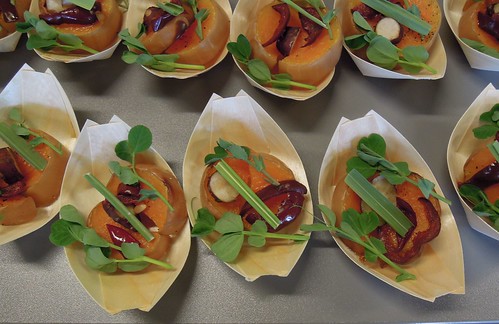
Baked pumpkin with Jerusalem artichoke, pepper, pee shoots and lemongrass
© Randi and Svend Sørensen
Food workshop – Samples and recipes with Danish Seed Savers own varieties. Part of Danish Seed Savers spring course, medio March.
Early in the winter I was asked to do a food workshop in March. Almost all crops was harvested and eaten by then. It was too late to sow new crops. Or so I thought. It turned out that I had time to cultivate pea shoots. And winter was mild, so there were left over small turnips in the garden, though the best was eaten. And while the focus was on seed saver cultivars, wild plants could also be included. And some fellow seed savers offered some of their crops for the day. So even in mid-March it was possible to present a wide range of flavours and cooking methods.
The samples was organised in stations. Clever women helped me set up the stations early in the morning. Each station should present a little harmony, but the order of stations should also guide taste buds through a landscape of sour, salty, bitter, umami and sweet. I had used very little spices, at the cultivars taste should be brought out. I had no intentions, that participants will copy this at home, but I hope the will feel empowered to explore old cultivars and wild edibles at home. Delicious cultivars are easy to preserve for future. Cultivars you don’t like to eat tend to be a pain to keep in culture. But often the difference is in the preparation.
The little old Errindlev pea was only four seeds from extinction. It was presented to the seed savers as an almost inedible, but old cultivar. I had been grown by an old woman in a village. She presented the seeds to younger people, but somehow her knowledge on the cultivar didn’t follow the seeds. Indeed, eaten as a green pea, it is no pleasure at all. But as a snow-pea and as a dry grey pea it is gourmet food. It almost became extinct before proper uses was discovered. Hereafter I listen more carefully to old people when they hand over their unique cultivars.
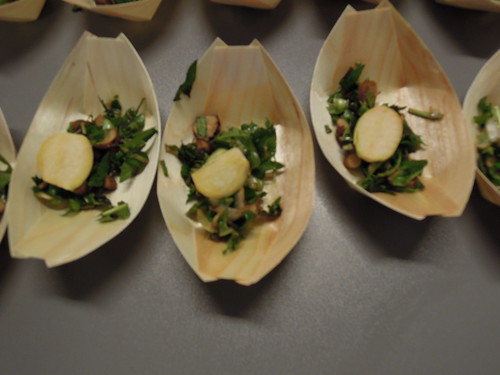
Salad of dandelion and turnip
©Randi og Svend Sørensen
Station 1
Salad of dandelion root and leaves, turnip and ramsons, with a pine oil and verjuice dressing
My thought was that it’s good to start with a salad. I have experience with this combination, where dandelion sweetness, nuttyness and bitterness plays well against the turnips sweetness and kale flavour. Ramsons provides an experience in a completely different level and an opportunity to bring your mind off the dandelion bitterness. The salad sets the stage for subsequent stations.
Dandelion: Weed from my own garden, cleaned and cut into suitable pieces. The flavor is both bitter, sweet and nutty.
Turnip: Petrowsky Gulia, Ohlsens Enke strain, Vangede 1948. Originally I got the seeds from the NordGen genebank, has now grown it for two generations. A nice yellow turnip. In autumn, the peel is pretty sharp tasting, like radish. To my surprise, here in March, it’s quite mild and there is no reason to tear off the peel.
Ramsons: Picked in the nearest wood a few years ago, sliced, fermented and stored in sealed glass in the refrigerator. Appearance, aroma and texture quite like freshly fermented ramsons. A strong aroma could be felt throughout the room, although there were only used very small amounts. When it comes to ramsons, fermentation intensifies and improves the garlic-like aroma. It does not take more than 5-10 minutes to pick what I use in a year. Ramsons has a fairly long picking period in April and May. Be sure to identify it properly, as some people get poisoned from mistakenly eating Lily of the Valley or Colchicum.
Oil: Siberian pine nut oil. An oil with a slight hint of resin. Many know the resin taste of Greek retsina wine.
Verjuice: The juice of unripe Rondo grapes from my own garden. To increase shelf life, I vinegar fermented the verjuice with kombucha / vinegar culture. In this way it contains both tartaric acid and acetic acid formed by fermentation and the acidic profile of the salad becomes more balanced. Wine variety Rondo sets far more grapes than it can mature. I have to thin out in the grapes anyway, and then it’s wonderful to use it for a gourmet product like verjuice.
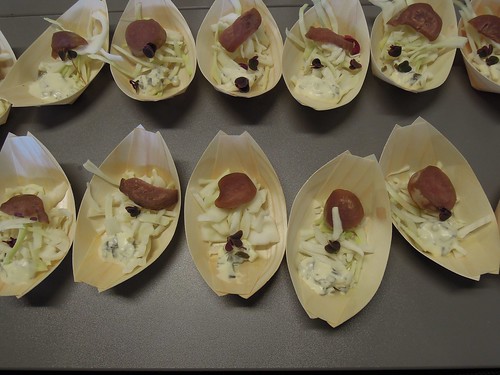
Chopped cabbage with eggplant, oca leaves and victory onion
©Randi og Svend Sørensen
Station 2
Chopped cabbage with eggplant, oca leaves and victory onion
Danish use of raw cabbage has shocked all Russians I know. That we eat chopped white cabbage, without doing more of it, is totally hardcore for a Russian. They will either squeeze it with a little salt, or ferment it. At this station, we taste the Danish version, to remember it when we later taste the other versions. To balance the raw cabbage, I add acid in various forms: fermented eggplant, oca leaves with oxalic acid and the sour cream with victory onion. It is reminiscent of wild ramsons, and yet, not quite?
Cabbage: Purchased organic import from the Netherlands. The chopped cabbage is a standard winter salad in Denmark. It is included here for comparison of chopped white cabbage in later stations where it is respectively squeezed and fermented.
Eggplant: Grown outdoor in my own garden. Lactic acid fermented with garlic topsets (forgot the variety) and mild chilli, Medina. It is unusual to eat eggplant raw, but it’s fine when it is fermented – it can save a lot of CO2 :-). Fermentation seems like a long marinating, creating its own acidity and allowing flavour of garlic and mild chilli to penetrate the eggplants completely. If you have cold storage, either in a cold pantry or refrigerator, the various pickled vegetables are easy fast food, letting you balance a meal in a hurry.
Oca: I put my oca tubers for sprouting weeks before, to garnish with the fresh acid tasting clover like leaves. As oca is daylength sensitive, is almost impossible to grow big oca tubers in Denmark, but easy to make many small tubers. They store well in a paper bag at room temperature, and can be set to sprout fresh and neat leaves.
Victory onion: Brought from Irkutsk in Siberia. Victory onion, Allium victorialis, is a relative of ramsons. It is harvested from wild populations in the Siberian taiga, fermented and sold in marketplaces. In sour cream (smetana) it acts as a sauce or dip. Have as salted ramson potent aroma, slightly different, but clearly related. In my garden it grows at a slow pace like peonies. It is highly ornamental, a true perennial edimental.
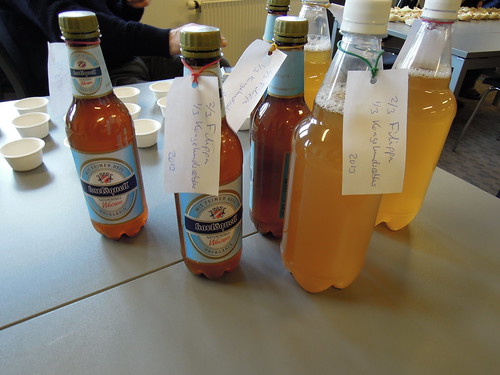
Cider
©Randi og Svend Sørensen
Station 3
Cider from Filippa apples and seedling apples from the local wood
Time for a little drink to clean the mouth and refresh the taste buds.
Filippa: Fallen apples from my garden fermented into cider. The delicate Filippa taste is evidently in the cider
Apples from seed grown trees: Several places in the local wood are growing apple trees obviously grown from seed. Every one of them are unique. None of them are juicy like Filippa. I have the impression, that they didn’t really do anything for the cider, just being bulk. No problem, as I needed some apple juice to fill the fermentation tank.
The cider was started with a bottle of home made cider, to get fermentation started quickly. When the fermentation was ended, I bottled the cider with a little sugar to a get a light secondary fermentation. This carbonates the cider.
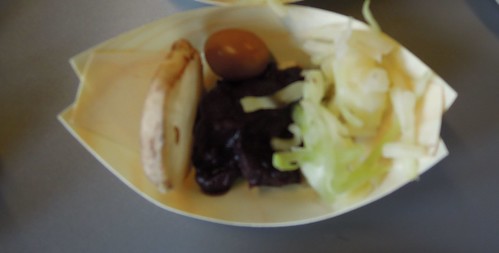
Grey peas, cabbage, cherry plums and Jerusalem artichoke
©Randi og Svend Sørensen
Station 4
Cooked grey peas, with squeezed white cabbage, fermented cherry plum and Urodny Jerusalem artichoke
Danish Seed Savers doing an EU founded project on rediscovering old peas and beans these years, calls for the use of grey peas. They need some crunch and acid from other elements for contrast.
Gray pea Lollandske rosiner: Old type of field peas grown by some seed savers. Soaked overnight with a teaspoon baking soda in the water. Then boiled two hours in fresh water with ½ teaspoon of baking soda. Since both yellow and grey peas are best second day, they were boiled up again and only this time I added a little salt. The peas do not disintegrate, but look like raisins in its own brown gravy. The taste is wonderful, although it is a very simple and inexpensive dish. Indeed, it’s also a healthy dish.
Squeezed white cabbage: Same cabbage, cut at the same setting on the mandoline. In this version sprinkled with a little salt and squeezed in a bowl. It takes approx. ½ hour, but you do not squeeze the cabbage continuously. Start squeezing it thoroughly for 2-3 minutes so that the cell walls burst. This releases enzymes, which starts a process that cures the cabbage to a gentle salat, even easier to digest. With 5-10 minutes intervals squeeze it again, and gradually it gets very juicy. The finished squeezed cabbage keeps for a week in the fridge. Make a big portion, and have fast healthy salad rest of the week.
Fermented cherry plums: Personally, I have had a slightly strained relationship with cherry plums. My mother was young during World War II. It taught her not to distinguish between plums and cherry plums. My childhood was therefore filled with cherry plums prepared by plum recipes, and it is not always successful. But a cherry plum tree in my garden has challenged me, and when I started fermenting cherry plums, it changed my view on cherry plums. When ripe and sweet, the fermentation will be alcoholic, due to the sugar content. This can probably become something wonderful too. But I pick cherry plums when they are still green but starting to turn yellow, and the sugar content still low. I wash them quickly in cold water, prick them with a fork, cover them in cold water with 5% salt and weigh them under the liquid surface with a plate. Then I store them at room temperature, to kick start the fermentation. After one to two weeks fermentation, I relocate them to a cooler setting (in the bottom of my pantry). Immediately before eating them, I soak them well in water to remove some of the salt. When young they taste very fresh and tangy, you can feel the carbon dioxide bubbles on the tongue. Later, after Christmas, the almond flavour of the kernels become more obvious, giving more depth to the flavour.
Jerusalem artichoke Urodny: This variety of Jerusalem artichoke is at the top in taste tests. And it is a clone everybody like, if they like Jerusalem artichokes at all. Here served sliced raw.

Baked pumpkin with Jerusalem artichoke, pepper, pea shoots and lemon-grass
©Randi og Svend Sørensen
Station 5
Baked Trombo d’Albenga musk pumpkin with Dwarf Jerusalem artichoke, green pepper, Errindlev and Engelsk Sabel ESA pea shoots and lemon-grass
Baked pumpkin is soft mild carbohydrates. They must be pepped up and meet contrasts. Here in the form of crunchy Jerusalem artichoke and sour peppers. We will discover, if we like this Jerusalem artichoke, and compare it with the taste of Urodny from an earlier station. Do we experience a difference between the two varieties of pea shoots. We will experience the taste of vinegar fermented pepper.
Trombo d’Albenga musk pumpkin: Musk Pumpkin is heat-lover, and need a good summer to succeed. This northern Italian cultivar does seem to be among the best adapted. It can be used both as a summer squash and winter pumpkins. Here I cut the long massive neck in slices and baked them in the oven, with a little salt and pepper. All pumpkins (and cucumbers) is high in potassium. This can be balanced with the sodium of salt.
Dwarf Jerusalem artichoke: Served sliced raw. This clone divide people. Either you think it’s the world’s best Jerusalem artichoke or the worst of all! In taste tests, no one find it to be in the middle. Taste it before you grow it. The flavour is intense nutty with dark mineral tones.
Acetic fermented outdoor peppers: Green peppers are really good sliced and put in kombucha with spices and stored in the refrigerator. Here they were spiced with garlic topsets, a little mild chilli Medina, and a little verjuice. Kombucha should not be too young, but have developed a good acidity. In my kitchen, this corresponds to at least 2 weeks fermentation. You can also use kombucha fermented apple juice (apple vinegar). Acetic fermentation in this style differ from traditional pickling in that the acetic culture is alive. I find the method good for vegetables that will not fare well in a lactic fermentation. Typically dark green vegetables. Some will surely love lactic fermented green pepper, I just do not. In contrast, the red pepper is irresistible when lactic fermented.
In this method, the kombucha or vinegar is fermented already, allowing you to use herbs that would otherwise inhibit fermentation.
Errindlev pea: The peas were put to germinate about 14 days before, mostly in the greenhouse, but inside during cold periods. Shoots were served raw. They can also be used on top of a soup, in salads or in a wok. This variety is actually a grey pea, ie. a dry pea. But it works great as snow pea and pea shoots.
Engelsk Sabel ESA: Same treatment and serving as Errindlev pea. This variety is a tall snow pea, a strain developed by Ohlsens Enke, and preserved in Nordgen.
Lemon-grass: A piece of fresh leaf on top, to give a little fresh lemon aroma. People do not eat lemon grass, but chew on it, to enjoy the taste. This clone I once brought home from Thailand. In the summer, put it out in the kitchen garden, in winter, taken in to the house. This clone provides large lemon-grass stalks. When drying lemon-grass flavour is well preserved, as opposed to lemon balm, which lose flavour in drying.
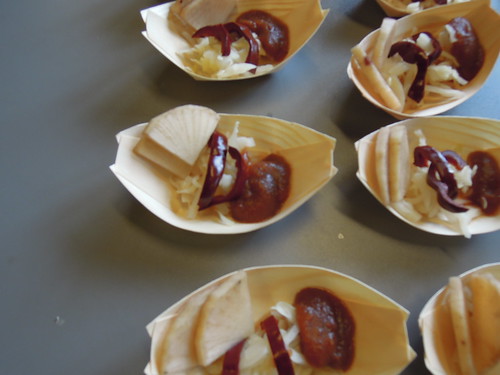
Fermented cabbage with yacon, hawthorn ketchup and red pepper
©Randi og Svend Sørensen
Station 6
Fermented cabbage with yacon, hawthorn ketchup and red pepper
Here we come to the last cabbage, which is lactic fermented. As a German sauerkraut, without caraway, only slightly fermented, and still alive. We shall try yacon, which many have not yet tasted. In the wild end we taste the hawthorn ketchup. We also see the difference from the fermented vinegar peppers in the station before and this stations lactic fermented red pepper.
Fermented cabbage: Same cabbage and cut at the same setting on mandolin, as the chopped and squeezed cabbage from previous stations. This cabbage was treated like squeezed cabbage, and then immediately pressed into a glass, so the juice covered the cabbage. Close the lid and let ferment for one to two weeks. Every day unscrew and re-screw the lid, to relieve the pressure. It also gives a good feel for the fermentation progress. When you are satisfied with the result, store the fermented cabbage cool. The refrigerator keeps it fresh for a very long time, at higher temperatures the fermentation continues, depending on temperature. But there is plenty of time to use the fermented cabbage, even at not so cold temperatures. The fermentation can be varied endlessly with other vegetables, appropriate condiments and different slicing techniques. For those who do not eat fermented milk products, fermented vegetables provides the beneficial bacteria in your diet.
Yacon Morado: Grown by Kirsten Hedegaard.
Yacon is still a new vegetable in Denmark. Nutritionally, it resembles Jerusalem artichoke, but in terms of taste, one might call it the watermelon of root vegetables. Served raw, as here, it is sweet, juicy and crisp. Used in baked root vegetables it keeps its crispness quite a while before it finally starts to get soft. This variety is Morado, which has proven to be easy to grow in Denmark. It is grown almost as Dahlia. It is frost sensitive, so the tubers should be stored frost-free. They last well into spring by proper storage, and can thus still be used when Jerusalem artichoke season ends.
Hawthorn Ketchup: Hawthorn ketchup for today was made with few spices to give a clearer impression of hawthorn berry taste. It is my experience that you have to taste the berries before you pick them. Pick from the bushes with best tasting berries.
Red open ground pepper: This is breeding material, that in a few more generations can become a new pepper cultivar. I grow it in the open air in each generation to make sure it will be a tough line. These ripe red peppers I have lactic fermented. Lactic fermentation brings out the best in mature red pepper (and maybe the worst in green?). I added garlic and verjuice to intensify the flavor. Verjuice make the pepper taste even more of pepper.
Station 7
Kombcha, ground ivy, Daubenton kale and Bergenia
Sorry, no photo. Again a little fluid on the palate. This time in the form of kombucha. For the brave, there is a version infused with fresh ground ivy. When you taste something unknown, it can feel reassuring holding something well known in the other hand. For this purpose I served some freshly cut Daubenton kale. The adventurer may also try a Bergenia tea.
Kombucha: Acetic fermented sweetened black tea. For this sample fermented five days, to preserve some of the sweetness. For other uses I ferment it two to four weeks.
Ground Ivy: A lovely spring flower and herb. I pluck it, and let it rest in kombucha some hours before filtering. Then, it can last a long time in a bottle in the refrigerator.
General considerations about kombucha and herbs: Many herbs can slow or change the kombucha fermentation. To prevent this I suggest you first do your kombucha, prepare a new batch, and only then infuse your herbs in kombucha. In this way, your mother culture is never exposed to the herbs antibiotic substances.
Daubenton kale: Small stemshoots served as a snack for kombucha. They were all eaten with eager, except what people took home as cuttings. This summer, there must be many small cabbages in many a seed saver garden derrived from this food workshop 🙂
Daubenton kale is a leafy brassica that never blooms, and therefore do not produce seeds. The are longlived, but can die off in cold winters. After a mild winter like this year, it is fantastic, filled with tiny tasty leaf shoots, which can either be eaten or used for cuttings.
Bergenia cordifolia: This plant I brought as tea leaves from my garden, and a Thermos of the fresh tea. Again I was surprised by the willingness to taste. In Siberia and Mongolia, it is not unusual to drink Bergenia tea. I recognize the taste. I was served this tea on several occasions in Siberia, without being told that this was different from not black tea. A mild black tea appearence, gentle flavour. You harvest this tea by picking the blackened leaves in february or march. Then the bitterness has leached out in winters rain. I washed the leaves in the kitchen sink before I wiped them dry and hanged for completely drying before storing.

“Cabello de ángel” and garlic cookies
©Randi og Svend Sørensen
Station 8
“Cabello de ángel” and garlic cookies
The end is near, and many wish some real sweet in the mouth now. A reward of jam on bread, which is probably not challenging, and the more challenging cookies with garlic.
“Cabello de ángel”: This was served on a small piece of bread. The jam was made from a Siam seven year melon (Cucurbita ficifolia) by Kirsten Hedegaard, who also grew it in her garden. Siam is a very durable pumpkin that easily holds 1-2 years at room temperature, or maybe even 7 years, as the english name suggest? The flesh is white and stringy, black seeds. The flesh is also used in modern shark fin soup, saving the endangered sharks of the oceans. The seeds are also very tasty. I prefer them to C.pepo seeds.
Garlic Cookie: Oatmeal cookies baked with almonds, garlic and a little salt. There are several kinds of pastries with garlic that has been presented at our danish garlic competitions. It seems that to be good in pastries, the garlic must either be combined with chocolate or salt. Garlic in the sweet kitchen challenge our cultural concept of sweet and onion, but can easily be successful for those who are willing to accept the challenge
Station 9
Green and full ripe fennel seeds
Last station must open our eyes to the importance of harvest timing. And it must be the ending point for all previous stations. Inspiration comes from India, where I often got a little nip of anise seeds, when paing for a meal in a restaurant.
Fennel: At the end of the taste tests were two kinds of fennel seeds. Fully ripe seeds, which are also suitable for sowing. These seeds were harvested 2013. The second kind were harvested green in 2010. It was interesting that although both types taste of fennel, the green harvested, although old, had a finer and stronger flavour. The seeds were harvested in my garden, where I grow fennel as perennials
A big thanks to the talented women who helped me organize this workshop.





























